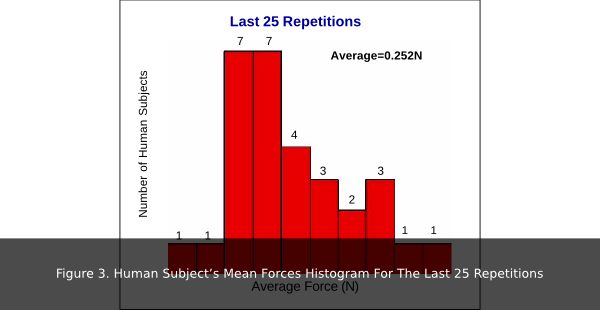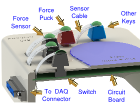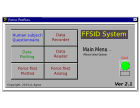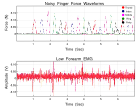Jose L. Agraz, PhD
Finger ForceFinger Force : Study

Goals
The goals of the pilot study were to test the operation of the hardware and software, to determine the usefulness of the system and to tests the effectiveness of the apparatus in producing force profiles for future research.
Experimental Design
In an effort to limit the number of variables tested during the pilot study, an
ergonomically efficient keyboard was used. In addition, a wrist brace was used to
limit the motion of the wrist. Also, Velcro was used to attach the wrist brace to the
keyboard and to keep the wrist from moving while resting the hand on the keyboard.
Each human subject was asked to use the index finger from the right hand to
tap on to the keyboard key repetitively until the onset of fatigue felt either in subject's
arm and/or index finger (Figure 1).

Experimental Protocol
In order to compare human subject's finger-force profiles, the following test procedure was consistently used for each test session:
- An explanation about the purpose of the research was given to the subject, followed by the description of the possible applications of the study's findings. The subject was then told what to expect in the experiment and asked to read and sign an informed consent form.
- An oral review was given about the test procedures, with a demonstration of finger and hand positioning.
- The subject was fitted with the wrist brace and helped to position the index finger and wrist on the keyboard.
- After the subject felt confident and had practice fairly well, the actual test began.
- The subject was asked to fill the electronic human-subject questionnaire
- The subject was asked to perform an isometric exercise on the keyboard to determine a target force
- The subject was asked to type repetitively one key using the index finger, until the onset of fatigue.
- At the conclusion of the test session, the data was saved onto a data disk.
Recruitment of Subjects
All ten subjects of mixed gender, ranging in ages from 21 to 40 years, were San Diego State University electrical engineering students (geeks). They were each asked to read and sign a consent form and participated in the pilot test that lasted an average of 15 minutes. Subsequently, they were given a gift certificate to acknowledge their participation.
Human Subject Testing
The objective of this study deals with the development of a system that can easily and accurately measures the generation of sequential finger-force. Limited experimentation was conducted using students at San Diego State University (SDSU) to evaluate the applicability of the system. Human volunteers used the sequential finger force system. Initially, subjects were required to depress the key in time to a metronome set at 1 stroke per second. This test evaluated the reliability and durability of the device. Subjects were seated comfortably and the sequential finger force-measuring device was placed so that their right elbow would form a right angle. A second set of experiments consisted of the subjects sequentially depressing all the keys. Subjects were requested to depress each key separately and continue until they felt fatigued.
Analysis of results
The analysis of the force data was performed off line by the Force Peak Search Analysis Program developed exclusively for this project. This program reads the force data recorded previously and selects the maximum force value for each repetition. Then, using these new force values, the program creates an ASCII file easily readable by other analysis software such as SPSS. The analysis of variance (ANOVA) test was performed on the individual subject averages using a statistical software package, SPSS 7.5 for Windows.
Statistical Analysis of Performance Report
The average of the first 25 repetitions of the force applied for all 30 subjects
are shown in table 1 and histogram (Figure 2). Note that the mean force is 0.25N.
Additionally, the averages of the last 25 repetitions of the force applied by the
same 30 subjects are shown in table 2 and histogram (Figure 3). Note that the
mean force is 0.25, which is the same mean force as the first 25 repetitions.
It was hypothesized that because of the fatigue of the individual subject, the
force level applied during the last 25 repetitions would be significantly less than the
force applied during the first 25 repetitions.




Ha: Force applied during the last 25 repetitions would be significantly less
than the force applied during the first 25 repetitions.
To test this hypothesis an Analysis of Variance (ANOVA) test was performed
on the individual subject averages using SPSS 7.5 for windows, a statistic software
package for the personal computer. The sources of variance used in the analysis
were the first 25 repetition force averages and the last 25 repetition force averages of
all 30 subjects. The sources of variance were analyzed to determine whether fatigue
(last 25 repetitions) has any significant influence on the force applied.
The result of the analyses using ANOVA is shown in 3. The fatigue
level (last 25 repetitions) that was hoped to have a significant effect upon the
subjects’ force level was found not to be statistically significant in the ANOVA test.
Significance was defined as having a p level less then 0.5N, but the ANOVA test had
a Sig. of 0.152N.
Pilot study conclusions and discussion
As previously mentioned in preceding chapters, the goal of the pilot study was to test the operation of the hardware and software and the usefulness of the testing apparatus. The second goal was to collect some useful information about fatigue from typing.

Although, it was logical to hypothesize that the fatigue would influence the
force level applied by the subjects, the result from the test revealed no statistically
significant findings.
The differing learning abilities of the subject may also indicate that a single
five-minute test may be inadequate to effectively evaluate the subject’s performance
on the keyboard. In addition, none of the subjects conducted the experiment at the
same rate. The use of an environment closely resembling a workplace by using a full
size keyboard to the hardware may give results that would support the hypothesis.
In conclusion, this pilot study evaluated and confirmed the usefulness of the
test apparatus. Force data was collected from 30 human subjects, which signal
shapes concurred with a previous study from David Rempel. In addition, this
system provides a wide range of sampling rate (1KHz-250KHz), a much lower cost,
and an 10 data collection channels; five force data and five digital data channels
from the keyboard keys.
Conclusions and Recommedations
The results from this study indicate that future studies using this device could benefit from the following recommendations:
- A full size keyboard is needed to realistically test the force individuals use during typing on their daily jobs.
- In order to decrease the total cost of the system, the use of a microcontroller- based system would eliminate the need for a personal computer and an expensive DAQ card.
- A RF, or TCP/IP link from the force-measuring keyboard is needed, as is a central computer for analyzing the data.
Recommendations For Improving Individual Force Sensors
There are several improvements suggested for the system described in this paper. One of them is the relocation of the sensors to a place where the sensor doesn't have a direct contact with the outside world. In order to avoid wear and tear, it would be a good idea to place the sensors underneath the keycaps. However, care must be taken to avoid inaccurate force reading because of an indirect interaction from the fingers and/or the direct interaction of other hardware with the fingers.
Recommendations For Future Expansions
The use of a seven-key keyboard does not result in a truly accurate force profile. Although the results are very useful and interesting, the use of a full-size keyboard will more nearly resemble the daily force profiles produced while at the workplace. The development of a full-size keyboard will be a much better tool with which to analyze the force profiles of human subjects. In addition, the development of a complete software package system, performing data acquisition and real-time ANOVA analysis would be a great software improvement.
Summary
This system was proven to be very useful in the exploration of finger force over time. Also, the system proved rugged and flexible enough to accommodate fine- tuning changes on hardware and software, with a minimum of dead time during the pilot study.
Download thesis here

 Introduction
Introduction
 Anatomy
Anatomy
 Methods
Methods
 Results
Results
Feb 14th, 2015 at 5:09 pm